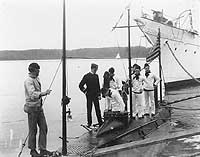
This page features the Online Library's May through September 2004 "What's New?" entries.
For the more recent entries, and links to previous years'
entries, see:
For earlier entries from the year 2004, see:
| If you want higher resolution reproductions than the Online Library's digital images, see: How to Obtain Photographic Reproductions. |
 The realities of "summer life" were a bit more persistent than anticipated, so it has been rather a long time since the last "What's New"! In any case, quite a few things did get done, Online Library-wise.
The realities of "summer life" were a bit more persistent than anticipated, so it has been rather a long time since the last "What's New"! In any case, quite a few things did get done, Online Library-wise.
Among those things was the posting of another photo album, this one covering, in photos and a beautifully typewritten text, the 1913 visit to Italy by the battleship Arkansas, in one of the periodic large-scale deployments the Navy conducted prior to World War I.
In addition, we completed our very large listing of World War I acquired vessels, permitting patrons to access photos of these ships and craft via their assigned "SP" and "ID" numbers, as well as by their names. Though presentations are presently completed on but a fraction of the total, ultimately these lists will include links to all of the vast number of acquired vessels for which we have images.
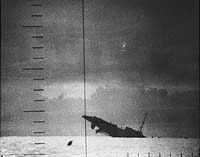 As might be anticipated, we also did a bunch of ships, including three destroyers named for the noted Civil War era officer George H. Perkins: Perkins (Destroyer # 26), Perkins (DD-377) and Perkins (DD/DDR-877). The destroyer Hopewell (DD-681) also made her Online Library debut.
As might be anticipated, we also did a bunch of ships, including three destroyers named for the noted Civil War era officer George H. Perkins: Perkins (Destroyer # 26), Perkins (DD-377) and Perkins (DD/DDR-877). The destroyer Hopewell (DD-681) also made her Online Library debut.
New submarines include K-3 (Submarine # 34), K-4 (Submarine # 35) and Seawolf (SS-197).
Other recenty-posted World War II and later U.S. Navy combatants are the frigate Machias (PF-53) and submarine chaser PCS-1391. New amphibious
 vessels are Outagami County (LST-1073), LCI(L)-809 and LCI(L)-815. Auxiliaries include cargo ship Etamin (AK-93, later IX-173, oiler Severn (AO-61), gasoline tankers Escatawpa (AOG-27) and Chehalis (AOG-48), and fleet tug Sioux (ATF-75). Three Civil War era ships conclude this part of a rather long report: the big, though short-lived, steamer California, the paddle-wheeler Saranac and the gunboat Wyandotte.
vessels are Outagami County (LST-1073), LCI(L)-809 and LCI(L)-815. Auxiliaries include cargo ship Etamin (AK-93, later IX-173, oiler Severn (AO-61), gasoline tankers Escatawpa (AOG-27) and Chehalis (AOG-48), and fleet tug Sioux (ATF-75). Three Civil War era ships conclude this part of a rather long report: the big, though short-lived, steamer California, the paddle-wheeler Saranac and the gunboat Wyandotte.
 In addition to finishing up their numerical listing, we also posted a whole lot of World War I era acquired vessels. Among them are the transports Kentuckian (ID # 1544) [actually a greatly expanded older presentation], Minnesotan (ID # 4595), Mongolia (ID # 1615) [from whose decks the Navy's first shot of World War I was fired],
Montpelier (ID # 1954), Shoshone (ID # 1769) and Troy (ID # 1614).
In addition to finishing up their numerical listing, we also posted a whole lot of World War I era acquired vessels. Among them are the transports Kentuckian (ID # 1544) [actually a greatly expanded older presentation], Minnesotan (ID # 4595), Mongolia (ID # 1615) [from whose decks the Navy's first shot of World War I was fired],
Montpelier (ID # 1954), Shoshone (ID # 1769) and Troy (ID # 1614).
Other auxiliary types include: cargo ships Lake Gedney (ID # 3765-C), Western Maid (ID # 3703), Western Spirit (ID # 3164), Westerdijk (ID # 2514) and William A. McKenney (ID # 2102); oiler Broad Arrow (ID # 2503); tugs Bouker # 2 (ID # 1275, later YT-30) and Mariner (SP-1136); and personnel ferries Gratitude (ID # 3054), St. Johns (ID # 3710) and Shuttle (ID # 3572).
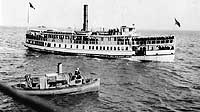 Newly added patrol types are: former yachts Galatea (SP-714), Mary Alice (SP-397), Naushon (SP-517), Sapphire (SP-710) and Seneca (SP-427); former fishing trawler Breakwater (SP-681); and motor boats Broadbill (SP-823) [which was later the Coast Guard cutter Swift], Buck (SP-1355), California (SP-647), Courtenay P (SP-899), Hobcaw (SP-252),
Me-Too (SP-155),
Owaissa (SP-659),
Whippet (SP-89), Whirlwind (SP-221) and Wiwoka (SP-250).
Newly added patrol types are: former yachts Galatea (SP-714), Mary Alice (SP-397), Naushon (SP-517), Sapphire (SP-710) and Seneca (SP-427); former fishing trawler Breakwater (SP-681); and motor boats Broadbill (SP-823) [which was later the Coast Guard cutter Swift], Buck (SP-1355), California (SP-647), Courtenay P (SP-899), Hobcaw (SP-252),
Me-Too (SP-155),
Owaissa (SP-659),
Whippet (SP-89), Whirlwind (SP-221) and Wiwoka (SP-250).
Finally, we added a steamer that the Navy inspected and numbered, but did not take over: West Lewark. Completed well after the end of World War I, she became the U.S. Army Transport Meigs.
24 September 2004
 Given the realities of summer life, and the call of the North
Woods, we'll begin and end our July report right here. The biggest
project undertaken during the past few weeks was the wholesale
scanning of a newly-obtained photo
album on the World War I era transport USS Scranton
(ID # 3511) (which was also named Pennsylvanian for
a few months in 1918). Until this album came our way, we had
absolutely nothing pictorial on this ship. Now, as you can readily
see, we have quite a lot, providing an interesting picture of
life on board one of the dozens of little-known ships the Navy
employed to bring World War I veterans home from France in 1919.
Given the realities of summer life, and the call of the North
Woods, we'll begin and end our July report right here. The biggest
project undertaken during the past few weeks was the wholesale
scanning of a newly-obtained photo
album on the World War I era transport USS Scranton
(ID # 3511) (which was also named Pennsylvanian for
a few months in 1918). Until this album came our way, we had
absolutely nothing pictorial on this ship. Now, as you can readily
see, we have quite a lot, providing an interesting picture of
life on board one of the dozens of little-known ships the Navy
employed to bring World War I veterans home from France in 1919.
 In addition to Scranton, transports pretty much dominate
our report. Most significant is a major presentation on USS Henderson (AP-1), the first
ship the Navy built "from the keel up" specifically
for transporting personnel. She was converted to a hospital ship
in 1943-1944 and spent the last two years of her service as USS
Bountiful (AH-9).
Two more World War I era transports were also done: USS Sierra
(ID # 1634) and USS Prinz
Friedrich Wilhelm (ID # 4063). Finally, presentations
were prepared on the minesweeper Penguin
(AM-33) and the submarine K-2
(SS-33).
In addition to Scranton, transports pretty much dominate
our report. Most significant is a major presentation on USS Henderson (AP-1), the first
ship the Navy built "from the keel up" specifically
for transporting personnel. She was converted to a hospital ship
in 1943-1944 and spent the last two years of her service as USS
Bountiful (AH-9).
Two more World War I era transports were also done: USS Sierra
(ID # 1634) and USS Prinz
Friedrich Wilhelm (ID # 4063). Finally, presentations
were prepared on the minesweeper Penguin
(AM-33) and the submarine K-2
(SS-33).
16 July 2004
 In the spirit of brevity, and in the hope that nobody will have
inflicted on them such an outsized "What's New" as
the last one, this edition covers but two weeks. Leading off
is coverage of a noted officer of the Civil War, Captain Percival Drayton (1812-1865),
and two destroyers named in his honor, Drayton
(Destroyer # 23) and Drayton
(DD-366).
In the spirit of brevity, and in the hope that nobody will have
inflicted on them such an outsized "What's New" as
the last one, this edition covers but two weeks. Leading off
is coverage of a noted officer of the Civil War, Captain Percival Drayton (1812-1865),
and two destroyers named in his honor, Drayton
(Destroyer # 23) and Drayton
(DD-366).
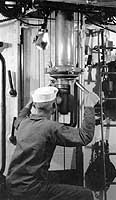 We also offer a page on another destroyer, Hopewell
(Destroyer # 181) and three submarines: H-5
(Submarine # 148), K-1
(Submarine # 32) and Grenadier
(SS-210). The internal combustion engine repair ship Leyte (ARG-8), which
was renamed Maui nine months after her completion, completes
our new presentations of relatively modern subjects.
We also offer a page on another destroyer, Hopewell
(Destroyer # 181) and three submarines: H-5
(Submarine # 148), K-1
(Submarine # 32) and Grenadier
(SS-210). The internal combustion engine repair ship Leyte (ARG-8), which
was renamed Maui nine months after her completion, completes
our new presentations of relatively modern subjects.
The rest of the fortnight's work revolved around World War I
acquired vessels. One of these is an enhancement of a pre-existing
page, courtesy of an "Online Library" patron who provided
us with two brand-new (to us, at least) pictures of the transport
Santa Malta (ID #
3125-A). Other freshly posted ships that were used as transports
include Black Arrow
(ID # 3913), Edgar
F. Luckenbach (ID # 4597), Julia
Luckenbach (ID # 2507), Mexican
(ID # 1655), and Walter
A. Luckenbach (ID # 3171). There are also several new
cargo ships, including:  Evansville (ID # 2996)
-- which began her Naval service as USS Lake Tahoe; West Galoc (ID # 3347);
West Grama (ID
# 3794); West
Indian (ID # 3120) and West
Shore (ID # 3129). The always fruitful category of former
pleasure craft and other small motor boats is represented by
Bobylu (ID # 1513)
-- one of our most "distinctive" vessels of war, Bonita (SP-540), Gurkha (SP-600), Welcome (SP-1175)
and Wendy (SP-448).
We'll wrap up the report with the ferry steamer Boothbay
(ID # 1708) -- which was renamed Grampus in 1920,
tug Blanche
(which had no ID #) and the hospital vessel Boston
Floating Hospital (ID # 2366).
Evansville (ID # 2996)
-- which began her Naval service as USS Lake Tahoe; West Galoc (ID # 3347);
West Grama (ID
# 3794); West
Indian (ID # 3120) and West
Shore (ID # 3129). The always fruitful category of former
pleasure craft and other small motor boats is represented by
Bobylu (ID # 1513)
-- one of our most "distinctive" vessels of war, Bonita (SP-540), Gurkha (SP-600), Welcome (SP-1175)
and Wendy (SP-448).
We'll wrap up the report with the ferry steamer Boothbay
(ID # 1708) -- which was renamed Grampus in 1920,
tug Blanche
(which had no ID #) and the hospital vessel Boston
Floating Hospital (ID # 2366).
Our next "What's New" will be a little more than two
weeks in coming, due to the timing of this year's annual departure
for the North Woods, but will be along sometime in mid-July.
28 June 2004
 As has been perhaps noticed, our "What's New" presentations
have been conspicuous by their absence for the past six weeks,
but we'll try to make it up to you in one fell swoop. The period
in question has been dominated by activities in but two areas:
submarines and World War I acquired vessels, but some other subjects
managed to creep in to liven things up. Taking first things first:
As has been perhaps noticed, our "What's New" presentations
have been conspicuous by their absence for the past six weeks,
but we'll try to make it up to you in one fell swoop. The period
in question has been dominated by activities in but two areas:
submarines and World War I acquired vessels, but some other subjects
managed to creep in to liven things up. Taking first things first:
Submarines -- There are plenty of new submarines. Starting
off with the very first submarine: Everything we have on USS
Holland (Submarine #
1) (or Submarine Torpedo Boat # 1, if you prefer), as well
as a page on her developer, the noted submarine pioneer John
P. Holland (1841-1914), whose contributions to the field
were far greater that the financial rewards he gained from them.
Holland is followed by all but one of the remaining "H"
boats: H-2 (Submarine
# 29), H-3 (Submarine
# 30), H-4 (Submarine
# 147), H-6 (Submarine
# 149), 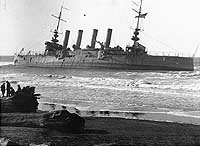 H-7 (Submarine # 150),
H-8 (Submarine # 151)
and H-9 (Submarine
# 152). Don't worry about H-5, it will be along presently.
Related to this subject area, we have also posted complete coverage
of the December
1916 stranding of the H-3 and all the fascinatinging
events that followed. That naturally brought about pages on the
protected cruiser Milwaukee
(Cruiser # 21), which was wrecked while attempting to salvage
the H-3, and two other participants in the effort: monitor
Cheyenne (ex-Wyoming)
and tug Iroquois.
For the record, the latter is a complete reworking and enlargement
of a half-decade-old relic of the Online Library's early days.
H-7 (Submarine # 150),
H-8 (Submarine # 151)
and H-9 (Submarine
# 152). Don't worry about H-5, it will be along presently.
Related to this subject area, we have also posted complete coverage
of the December
1916 stranding of the H-3 and all the fascinatinging
events that followed. That naturally brought about pages on the
protected cruiser Milwaukee
(Cruiser # 21), which was wrecked while attempting to salvage
the H-3, and two other participants in the effort: monitor
Cheyenne (ex-Wyoming)
and tug Iroquois.
For the record, the latter is a complete reworking and enlargement
of a half-decade-old relic of the Online Library's early days.
 Our submarine presentations are wrapped up, for the moment, with
pages on two German Type XXI advanced technology (for the day)
"boats" that the U.S. Navy ran during the later 1940s:
U-2513 and U-3008.
Our submarine presentations are wrapped up, for the moment, with
pages on two German Type XXI advanced technology (for the day)
"boats" that the U.S. Navy ran during the later 1940s:
U-2513 and U-3008.
Other subjects -- There are several of these, initiated
by coverage of Vice Admiral Glynn
R. Donaho (1905-1986), a very successful World War II submarine
officer who also did well in the post-war Navy. New ships in
this category include the frigate Peoria
(PF-67) -- which later became the Cuban warship Antonio
Maceo, sub chaser PCE-843
(later renamed Skowhegan), and auxiliaries Arctic
(AF-7) (originally the steamer Yamhill),
Saturn (AK-49, later
AF-40) , Hesperia
(AKS-13), and Stag
(AW-1), which was originally the "Liberty" ship
Norman O. Pedrick.
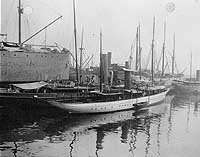 Ships and craft acquired during the World War I Era (take
a deep breath now, this is going to be long!) -- Leading these
off are the transports K.I.
Luckenbach (ID # 2291) and Rijndam
(ID # 2505); cargo ships Besoeki
(ID # 2534), Beukelsdijk
(ID # 3135) -- an example of the once-common "turret
ship" type, Rijnland
(ID # 2718) and Wassaic
(ID # 3230); tanker Amabala
(ID # 2185) -- proof that there was a sense of humor in the
World War I Navy (at least where ship renamings were involved);
and salvage ship Biesbosch
(ID # 2499).
Ships and craft acquired during the World War I Era (take
a deep breath now, this is going to be long!) -- Leading these
off are the transports K.I.
Luckenbach (ID # 2291) and Rijndam
(ID # 2505); cargo ships Besoeki
(ID # 2534), Beukelsdijk
(ID # 3135) -- an example of the once-common "turret
ship" type, Rijnland
(ID # 2718) and Wassaic
(ID # 3230); tanker Amabala
(ID # 2185) -- proof that there was a sense of humor in the
World War I Navy (at least where ship renamings were involved);
and salvage ship Biesbosch
(ID # 2499).
Among the patrol vessels are the former steam yachts Arcady
(SP-577), Cherokee
(SP-1104), Despatch
(SP-68, later PY-8) and Wanderer
(SP-132); ex-fishing vessels Billow
(ID # 1704) and Walter
Adams (ID # 400); 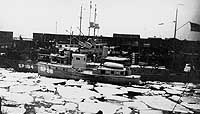 plus a sizable harbor full of motor boats (large and small).
These include Althea
(SP-218), Anna
Belle (SP-1206), Arcadia
(SP-856), Arroyo
(SP-197), Augusta
(SP-946), Barracuda
(SP-845), Betty
Jane I (ID # 3458), Betty
M. II (SP-623), Bie
& Schiott (ID # 2871), Coronet
(SP-194), Dean II
(SP-98), Edithia
(SP-214), Ellen
(SP-284), Weepoose
(SP-450) and Wemootah
(SP-201).
plus a sizable harbor full of motor boats (large and small).
These include Althea
(SP-218), Anna
Belle (SP-1206), Arcadia
(SP-856), Arroyo
(SP-197), Augusta
(SP-946), Barracuda
(SP-845), Betty
Jane I (ID # 3458), Betty
M. II (SP-623), Bie
& Schiott (ID # 2871), Coronet
(SP-194), Dean II
(SP-98), Edithia
(SP-214), Ellen
(SP-284), Weepoose
(SP-450) and Wemootah
(SP-201).
There is one harbor tug, the Amanda
Moore (which had no ID # assigned, and whose Naval service
is somewhat tenuous), and a great flock of barges, those unhandsome
and unromantic vessels without which neither the Navy nor commercial
shipping could have functioned. These, many of which subsequently
had Navy Coal Barge, Freight Lighter, and Floating Derrick numbers,
are:
 Anna O'Boyle (ID
# 1736), Annie
B. Embry (ID # 2401), Arthur
(ID # 1730), Atglen
(ID # 1315), Atlida
(ID # 1721), Bailey
(ID # 2370), Barge
# 6 (ID # 3373), Barge
# 8 (ID # 2876), Barge
# 62 (ID # 2729), Barge
# 66 (ID # 2604), Barge
# 70 (ID # 2678), Barge
# 72 (ID # 2986), Barge
# 76 (ID # 3030), Barge
# 84 (ID # 3168), Bessie
(SP-1755), Bessie
J. (SP-1919), Concrete
Barge # 442, Violet
(ID # 2395) and Washington
(SP-1241).
Anna O'Boyle (ID
# 1736), Annie
B. Embry (ID # 2401), Arthur
(ID # 1730), Atglen
(ID # 1315), Atlida
(ID # 1721), Bailey
(ID # 2370), Barge
# 6 (ID # 3373), Barge
# 8 (ID # 2876), Barge
# 62 (ID # 2729), Barge
# 66 (ID # 2604), Barge
# 70 (ID # 2678), Barge
# 72 (ID # 2986), Barge
# 76 (ID # 3030), Barge
# 84 (ID # 3168), Bessie
(SP-1755), Bessie
J. (SP-1919), Concrete
Barge # 442, Violet
(ID # 2395) and Washington
(SP-1241).
Lastly, assuming anyone is still awake, we added two more of
the hundreds upon hundreds of ships and craft that the World
War I Navy considered for acquisition, but didn't actually take
over. These are the trawler Wave
(ID # 1706) and the motor boat Barracuda
(SP-23)
17 June 2004
This page features the Online Library's May through September 2004 "What's New?" entries.
For the more recent entries, and links to previous years'
entries, see:
For earlier entries from the year 2004, see:
| If you want higher resolution reproductions than the Online Library's digital images, see: How to Obtain Photographic Reproductions. |
Page made 24 September 2004